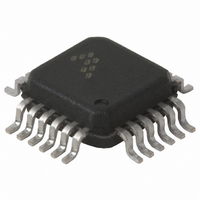MC33594FTAR2 Freescale Semiconductor, MC33594FTAR2 Datasheet - Page 5

MC33594FTAR2
Manufacturer Part Number
MC33594FTAR2
Description
IC RF RECEIVER 315,434MHZ 24LQFP
Manufacturer
Freescale Semiconductor
Datasheet
1.MC33594FTAR2.pdf
(28 pages)
Specifications of MC33594FTAR2
Frequency
315MHz, 434MHz
Sensitivity
-105dBm
Data Rate - Maximum
11 kBaud
Modulation Or Protocol
FSK, OOK
Applications
General Data Transfer
Current - Receiving
5.7mA
Data Interface
PCB, Surface Mount
Antenna Connector
PCB, Surface Mount
Voltage - Supply
4.5 V ~ 5.5 V
Operating Temperature
-40°C ~ 105°C
Package / Case
24-LQFP
Operating Band Frequency
315 to 434MHz
Operating Frequency (max)
434000kHz
Operating Temperature (min)
-40C
Operating Temperature (max)
105C
Operating Temperature Classification
Industrial
Modulation Type
FSK/OOK
Package Type
LQFP
Product Depth (mm)
4mm
Product Length (mm)
4mm
Operating Supply Voltage (min)
4.5V
Operating Supply Voltage (typ)
5V
Operating Supply Voltage (max)
5.5V
Lead Free Status / RoHS Status
Contains lead / RoHS non-compliant
Features
-
Memory Size
-
Lead Free Status / Rohs Status
Compliant
Other names
MC33594FTAR2TR
Available stocks
Company
Part Number
Manufacturer
Quantity
Price
COMMUNICATION PROTOCOL
MANCHESTER CODING DESCRIPTION
during the second half-bit.
is allowed. In order to achieve a correct clock recovery, Manchester coded data must have a duty cycle between
45% and 55%.
PREAMBLE, ID, HEADER WORDS AND MESSAGE DESCRIPTION
Register 2. The complement of the ID word is recognized as an ID word. ID word is sent at the same data rate as
data.
Using FSK modulation, it enables data slicer reference voltage to settle and clock recovery.
Figure 4 defines the Preamble word in FSK modulation. Preamble content must be carefully defined in order not
to be decoded as an ID or Header word.
rate. This bit sequence and its complement must not be found in the sequence preamble and ID word.
Data must follow the Header without any delay.
Even in case of FSK modulation, the data must be completed by a EOM and not by simply stopping the RF
telegram. If the complement of the Header word is received, output data are complemented too.
and an EOM. The preamble is placed at the beginning of both ID and Header words.
MESSAGE PROTOCOL
Consequently, the transmitted ID burst has to be long enough to include two consecutive receiver Run cycles.
© Motorola, Inc., 2002.
Manchester coding is defined as follows: data is sent during the first half-bit, complementary data is sent
The signal average value is constant. In FSK modulation (MOD=1), clock recovery from the data stream itself
The following description applies if the Data Manager is enabled (DME=1, MOD=1).
The ID word is a Manchester coded byte whose content has been previously loaded in the Configuration
A preamble is required:
The Header word is a 4 bit Manchester coded message ‘0110’ or its complement sent at the selected data
Data are completed by a End-of-Message (EOM) word, consisting of 2 NRZ consecutive ones or zeroes.
The following example shows a complete message with Preamble, ID, Header words followed by 2 data bits,
If the receiver is continuously Sleep/Run cycling, the ID word has to be recognized to stay in Run mode.
- before ID,
- before Header if HE=1,
- before data if HE=0.
FSK Modulation:
Data slicer reference settling time
Preamble
3 ‘1’ or ‘0’ Manchester
0
1 1 0 0 1 0 0 0
at data rate
1
Freescale Semiconductor, Inc.
For More Information On This Product,
Figure 3: Manchester coding example
Figure 5: Complete message example
MOTOROLA SEMICONDUCTORS PRODUCTS
0
ID
Figure 4: Preamble definition
Go to: www.freescale.com
0
‘1’ or ‘0’ Manchester
MC33594
1
Clock recovery
at data rate
5
1
Preamble
0
0 1
Manchester coded
Original data
Header
1
ID
0
Data
1 0
EOM
revision 1.1, 5 February 2002











